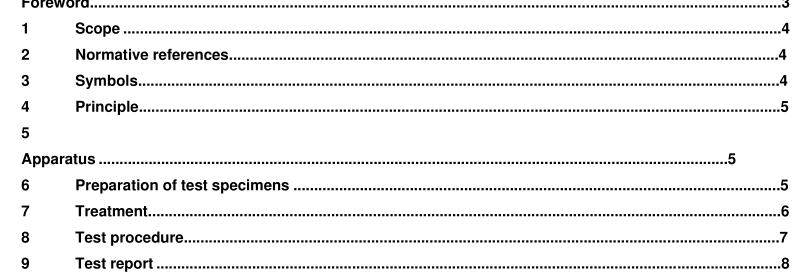BS EN 13580:2002 – Products and systems for the protection and repair of concrete structures — Test methods — Water absorption and resistance to alkali for hydrophobic impregnations

1 Scope
This European Standard specifies a test method to evaluate the effect of a hydrophobic impregnation. It deals with the rate at which treated concrete absorbs water and with the alkali resistance of that surface treatment. The method primarily relates to the protection of concrete structures.
2 Normative references
This European Standard incorporates by dated or undated reference, provisions from other publications. These normative references are cited at the appropriate places in the text and the publications are listed hereafter. For dated references, subsequent amendments to or revisions of any of these publications apply to this European Standard only when incorporated in it by amendment or revision. For undated references the latest edition of the publication referred to applies (including amendments).
EN 1 766, Products and systems for the protection and repair of concrete structures – Test methods – Reference concretes for testing. EN 1 3579, Products and systems for the protection and repair of concrete structures – Test methods – Drying test for hydrophobic impregnation.
4 Principle
Impregnants applied to the surface of the concrete reduce the ingress of water and salt solutions into concrete. The principle of the test method described in this standard is to compare rate of uptake of water of treated and untreated test cubes from the same batch of concrete. The ratio of the rates is defined as the absorption ratio. The long term durability is assessed by measuring the water absorption after a defined exposure to alkali.
5 Apparatus
5.1 Nine moulds for concrete cubes (1 00 mm x 1 00 mm x 1 00 mm).
5.2 Soft brush
5.3 Absorbent paper towel
5.4 Balance with an accuracy of 0,01 g.
5.5 Support for test cubes on bench in laboratory or in fume cupboard to allow air to circulate around all 6 faces.
5.6 Laboratory or chamber maintained at constant temperature (21 M 2) °C and relative humidity of (60 M 1 0) %
5.7 Forced air circulation oven to run at (1 05 M 5) °C.
5.8 Desiccator cabinet containing silica gel.
5.9 Fume cupboard.
5.10 Two suitable air tight boxes containing saturated potassium sulphate solution for storing specimens.
Note that treated and untreated test cubes must be stored in separate boxes.
5.11 One 150 mm diameter petri dish with 2 spacers glued to bottom of dish to support the test cubes during treatment
5.12 Demineralised water (conductivity < 50 µS).
5.13 Six 5 l beakers with suitable spacers to support test cubes.
5.14 Potassium-hydroxide solution (5,6 g/l).
5.15 Cling film.
6 Preparation of test specimens
Nine 1 00 mm concrete test cubes shall be cast from a single batch of Type C (0.45) concrete and cured for 28 days according to EN 1 766. No oil or release agent will be permitted on the surface of the moulds (5.1 ). After removal from the curing tank, the test cubes shall be cleaned with tap water using a soft brush (5.2) to remove any loose material. The surface of the test cubes shall not be grit blasted. The test cubes shall be surface dried with an absorbent paper towel (5.3) and then weighed (W ssd ) using the balance (5.4).
BS EN 13580:2002 – Products and systems for the protection and repair of concrete structures — Test methods — Water absorption and resistance to alkali for hydrophobic impregnations